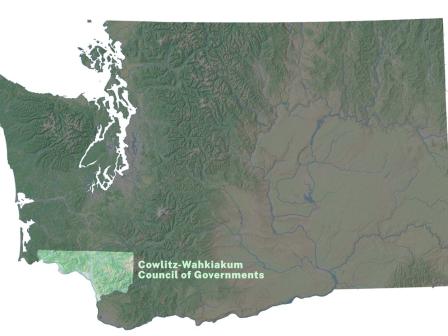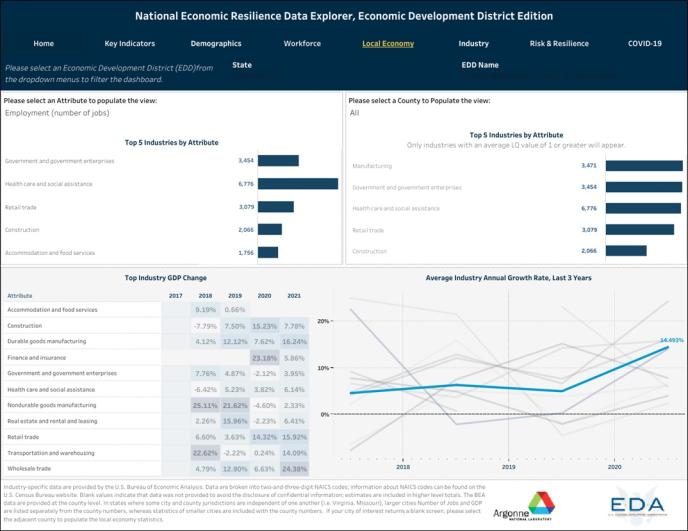
Archived Content
This site contains information that has been considered archived and will no longer be updated.
Data Driven Investing in America: New Tools Help Advance Regionally Focused Economic Development in Washington State and Beyond
New Tools Provide One-Stop Sources for Data
In 2018, Brookings reported: “A central development problem is that high-quality, timely, accessible data are absent in most poor countries, where development needs are greatest. In a world of unequal distributions of income and wealth across space, age and class, gender and ethnic pay gaps, and environmental risks, data that provide only national averages conceal more than they reveal.”
Through a collaboration with the U.S. Department of Energy’s Argonne National Laboratory, EDA is tackling this problem head-on. By drastically expanding the range of tools available to local and regional economic development authorities and federal grant applicants, EDA is putting more equitable, granular information than ever before directly into the hands of decision makers.
“Argonne data scientists, working with EDA economists and program staff, are setting a new standard for evidence-based, data-driven economic development,” said Alejandra Y. Castillo, Assistant Secretary of Commerce for Economic Development (EDA)
The recently launched Economic Development Capacity Index (EDCI) aggregates near real-time data from more than 50 economic indicators to determine a given region's economic development capacity compared to the rest of the nation. Using EDCI, a region can generate a snapshot view of its economic capacity in one of five major areas: human capital, finance, industry composition, infrastructure, and institutional support.
The National Economic Resilience Data Explorer (NERDE) is a comprehensive, web-based tool that centralizes a range of publicly available data about local and regional economic conditions, including information on economic distress, demographics, industry clusters, and the impact of COVID-19 on local economies. Data is provided at both the county and Economic Development District (EDD) levels and is updated monthly.
Castillo added, “NERDE and EDCI bring together a broad range of data sources to help communities identify their economic development strengths and opportunities for growth.”
NERDE Used to Inform Cowlitz-Wahkiakum COG Gap Analysis

For many small and medium-sized planning entities, accessing the resources needed to develop the research-driven insights that inform a new or refreshed Comprehensive Economic Development Strategy (CEDS) can be challenging.
That was the situation Bill Fashing found himself in when the Cowlitz-Wahkiakum Council of Governments (COG) — an EDA-designated Economic Development District (EDD) in Southwest Washington state — started the process of updating their CEDS.
“During a CEDS year, the CEDS is the focus of much of our attention,” explains Fashing, who – as executive director of the Cowlitz-Wahkiakum COG – oversees a staff of eight people responsible for a range of regional services, from administering a Revolving Loan Fund, to providing transportation planning for the Longview-Kelso-Rainier metropolitan area.
For Fashing and his co-workers, the process of drafting the new CEDS took more than six months and involved multiple public meetings, as well as one-on-one interviews with three dozen local stakeholders. Anecdotal evidence to support their development goals was relatively easy to source; but detailed facts and figures that point to needs in the region were harder to find.
NERDE, however, helped lessen some of the Cowlitz-Wahkiakum COG’s workload by providing reliable, local data in an easily accessible format. The Cowlitz-Wahkiakum COG used the tool to develop their CEDS evaluation framework. It helped the district conduct a gap analysis between EDD-level unemployment, income, educational attainment, and poverty rates and the national averages for those measures.
“Research capacity is a huge issue and having something like this tool, which allows me to go to one place and get just about anything I need, is extremely helpful and time saving,” said Fashing. “I see even more opportunity using NERDE moving forward.”
Learn more about the Cowlitz-Wahkiakum Council of Governments, and view their new CEDS, at: cwcog.org.
